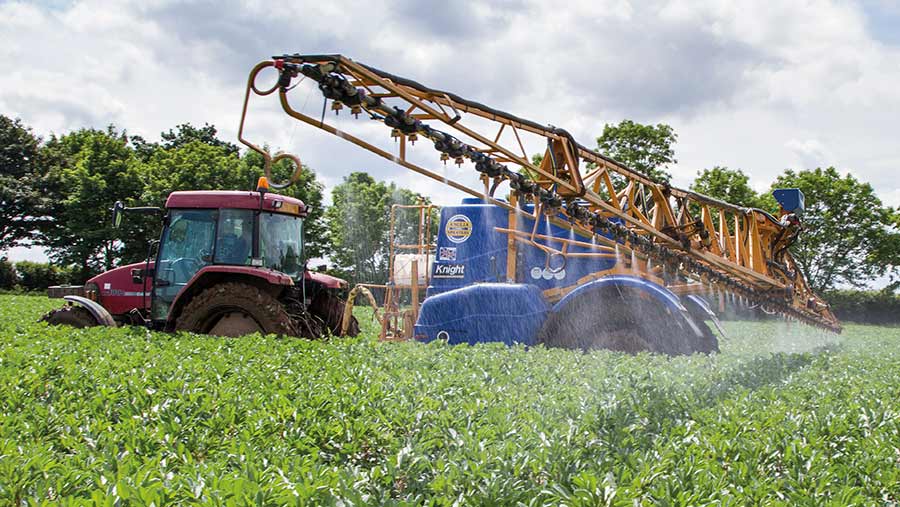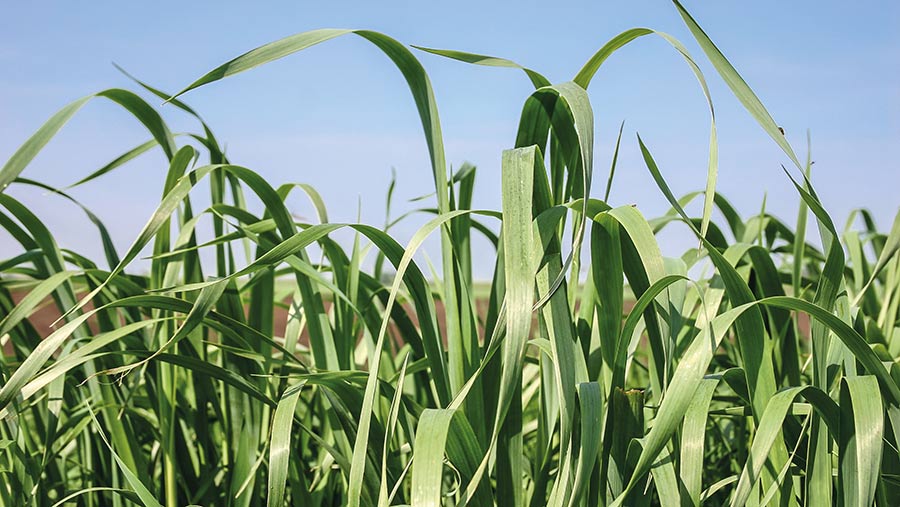Crop Watch: Costs soar with rampant chocolate spot and septoria
 © GNP
© GNP It’s a constant battle to keep on top of disease in winter wheat and beans in the soggy spring.
For winter wheat, septoria pressure remains high, and in dirtier varieties, growers are having to invest in more expensive, newer chemistry.
In beans, again traditional cheaper treatments cannot hold chocolate spot with conditions ideal for the fungus to thrive.
In sugar beet, aphid numbers are increasing and with it is the risk of virus yellows.
See also: How a Lincolnshire farmer grows a quality crop of herbage
West
Antony Wade
Hillhampton Technical Services (Hereford/Shropshire)
The recent weather pattern seems to have been two days of good weather interspersed with 10-14 days of heavy downpours, which have in places caused damage to crops such as winter barley and beans.
As we progress to the wheat flag leaf timing, it is worrying that we are splashing through water-filled tramlines and clients are questioning whether the move to row crop tyres was the right one.
The incessant rain has resulted in septoria levels that we have not seen in a number of years – I don’t think the latest chemistry has even been tested in such high septoria pressure.
Even where I have recommended high rates of an SDHI/azole co-form plus a folpet multisite at T1, we have lost leaves five or six to septoria, and the tips of leaves three or four are infected.
Later drillings have slightly less septoria loading, but this is relative in a season that keeps on giving in terms of challenges.
Due to the tight supply of fungicides, many farmers had to place orders well in advance of product use.
However, as the season and disease development has progressed, the T2 fungicides rates initially predicted have had to be increased to try to minimise the effects of very high septoria infection levels, and a multisite have been included.
Rapid barley growth
Winter barley crops have suddenly exploded into rapid growth, so it is now time to tensely watch these crops to see if they will stand in current very growy conditions.
Many crops will receive a foliar potassium application to minimise brackling issues.
Disease control has been reasonable so far. Rhynchosporium levels are noticeably lower on older leaves where we did manage to get the T0 applications on.
Oilseed rape crops are still flowering and the usual debate on whether to protect again at late flowering for sclerotinia is a decision to be made by the time this article goes to print.
Risk forecast has been low, but increased recently as soil temperatures have risen.
Most mid-flower sprays were applied in the third week of April and fungicide coverage is running out. My crops look to have good potential – the plant growth regulators (PGRs) used have controlled height and canopy well – we just need some sunlight to fill the pods.
Spring cereals and beans that only went in at the beginning of May are emerging, but some are being challenged by slugs and, unbelievable for May, some seed waterlogging.
East
Marion Self, AICC/Prime Agriculture (Suffolk)
Everything is growing well, including crops, diseases, weeds and pests. In disease-susceptible crops of wheat and winter beans we are fighting to prevent foliar disease infection in the yield-building leaves of the upper canopy.
In wheat there is a marked difference in the level of Septoria tritici between crops, affected by factors that influence disease pressure such as variety, time of sowing and fertility.
This may be a good time to consider your variety profile given the markets available to you. Is there something less susceptible you could grow with similar yield potential?
For the dirtier varieties, flag-leaf fungicide treatments are substantial as large amounts of curative and protectant activity are required.
The weather is hampering timings, but try to be as prompt as possible to achieve the best response to treatment.
The fungicide bill on some crops is eye-watering, but if the dose is appropriate, well timed and yield potential is good, the data show your spend will be well rewarded.
In wheat, yellow rust has been well controlled by treatments so far.
To continue this protection, flag-leaf treatments will be bolstered with an extra azole to give supporting yellow and brown rust control to the stronger septoria-targeting fungicides such as Univoq (fenpicoxamid + prothioconazole) and Revystar (fluxapyroxad + mefentrifluconazole).
Wheats have a lot of biomass and, in most situations, early PGR programmes will be topped up with a moderate to robust dose of a late-season PGR such as Terpal (ethephon + mepiquat) or similar.
Winter beans
Diseases in winter beans need monitoring, especially on forward, thick crops.
More traditional, cheaper treatments cannot hold chocolate spot at bay in these wet conditions, and treatment based on boscalid + pyraclostrobin may be required.
Good plant health and foliar nutrition are also required to help the plant resist disease.
Spring crops are growing fast, with many cereals requiring growth regulators.
These crops are racing through their growth stages, so be careful not to miss opportunities to apply planned treatments.
Blink and spring barley gets to the flag-leaf stage.
In general, sugar beet crops are establishing well, although growers should watch out for slugs, particularly after late-destroyed covers.
In most situations weeds are growing just as quickly, and growers have to wait for opportunities to spray.
In most areas, aphids that transmit viruses such as wingless Myzus persicae have arrived.
Their numbers are increasing, and when the economic threshold is reached in non-Cruiser-treated crops, treatment will be triggered with an approved foliar insecticide such as Insyst (acetamiprid) or Teppeki (flonicamid).
As a reminder, the threshold for treatment is one green wingless aphid per four plants up to the 12-leaf stage.
South
Jamie Swift, Procam (East Sussex)
As I write this piece, rain is lashing against the window with bright sunshine in the distance, a fitting summary of a very unsettled spring to date.
That said, most crops are looking more than pleasing and I’m quietly confident we’ll see better-than-expected yields at harvest.
Although growth stages are all over the place in some areas due to the unseasonal weather, winter wheats are progressing nicely and are now at or approaching the flag-leaf or T2 stage.
It is important to use the strongest active ingredients now, as a well-timed T2 application will contribute about 45% of overall yield.
Applying the right product at the right time is key, and knowing the strengths and weaknesses of your varieties will aid in the decision-making process.
Less-responsive varieties such as Skyfall and Zyatt will benefit from a strong mix when controlling yellow rust and septoria at this stage.
Where disease pressure is high, I will be turning to recent market entrant Lentyma (mefentrifluconazole), paired with a strobilurin – a mix that has shown excellent disease control at T2 in recent years.
If septoria is the main target and yellow rust infection is low, I will be dropping the strobilurin and opting for a multisite to give added activity.
Shorter OSR crops
Oilseed rape crops are in good order, with minimal crop losses reported in the South.
Crop survival has been greater than in recent years, but as I’m seeing in cereals, crop sizes are varied due to the continued wet conditions, with some OSR struggling to reach optimal height.
With most rapeseed reaching full flower, protecting against sclerotinia infection is the priority now.
Light rain with high night-time humidity creates favourable conditions for this disease, so I’m making use of the web-based infection risk alert system.
Shown as a traffic light system, this tool indicates if weather conditions are currently or likely to be suitable for the pathogen to infect crops.
Where thresholds are met, I’m applying a fungicide at mid- to full flowering to ensure good coverage and protect against further infection following petal fall.
Achieving adequate control is about timing.
Too early and you leave the crop vulnerable to late infection, and too late may mean infection has already occurred before spraying, after which control will no longer be possible.
North
Mary Munro
AICC/Strutt and Parker (Perthshire)

© Blackthorn Arable
All the winter crops have transformed in the past couple of weeks, and OSR is in full flower, turning the countryside into a patchwork of intense yellow.
My one fungicide of the season is going on at this stage. I have the same conversation with growers every year – how you can never predict the yield potential of oilseed rape by looking at it.
The crops have looked tremendous all year, but we simply cannot count on that translating into tonnes.
Winter barley awns are emerging and the T2s went on to hit the flag leaf, along with plant growth regulator and, if necessary, Axial (pinoxaden) for wild oats.
There have been one or two cases where a flush of broad-leaved weeds have needed attention.
Cleavers are the obvious one, and the latest undesirable weed, bur chervil, can be challenging if not targeted early in the spring.
Fortunately, this season has had better moisture, so we are not experiencing the very late germination of weeds that featured in 2021 and 2022.
Disease levels in the winter barley has been low all season.
Barley
Winter wheat is also looking good, although septoria is never far away, and the downside of wetter weather is the higher disease pressure.
I have kept timings tight to avoid long spray intervals and unprotected leaves.
Revystar (fluxapyroxad + mefentrifluconazole) will be the product of choice at T2 in nearly all my wheat crops.
Spring barleys are just getting their herbicide now, with manganese, and my plans vary.
The bur chervil sites get mecoprop-P plus Ally (metsulfuron) or Harmony M (metsulfuron + thifensulfuron) while the places with cleavers will get florasulam/fluroxypyr.

